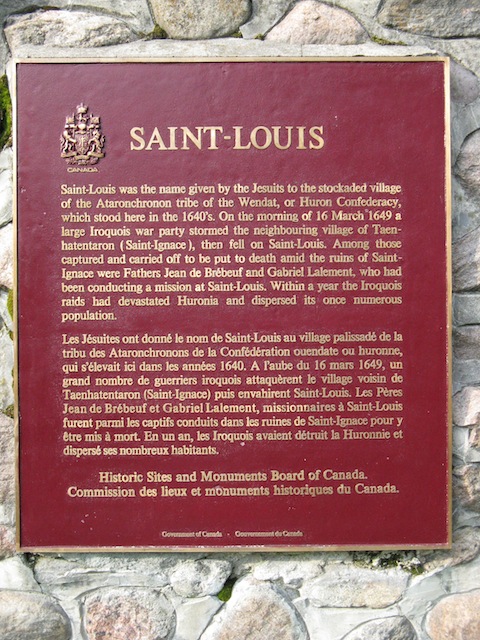Discover Ontario's history as told through its plaques
2004 - Now in our 15th Year - 2019
To find out all about me, you can visit the Home Page
Looking at this page on a smartphone?
For best viewing, hold your phone
in Landscape mode (Horizontal)
Saint-Louis

Photos by contributor Wayne Adam - Posted January, 2010
Plaque Location
The County of Simcoe
The Township of Tay
Off Granny White Sideroad, 3.3 km from the intersection of
Highway 12 and Park Street in Victoria Harbour
via Highway 12 and Granny White Sideroad
Coordinates: N 44 43.525 W 79 46.862 |
Plaque Text
Saint-Louis was the name given by the Jesuits to the stockaded village of the Ataronchronon tribe of the Wendat, or Huron Confederacy, which stood here in the 1640's. On the morning of 16 March 1649 a large Iroquois war party stormed the neighbouring village of Taenhatentaron (Saint-Ignace), then fell on Saint-Louis. Among those captured and carried off to be put to death amid the ruins of Saint-Ignace were Fathers Jean de Brébeuf and Gabriel Lalement, who had been conducting a mission at Saint-Louis. Within a year the Iroquois raids had devastated Huronia and dispersed its once numerous population.
Related Ontario plaques
Sainte-Marie Among the Hurons (1639-1649)
Sainte-Marie II
Gateway to Huronia
More
Information
More
Disasters
More
Tay Plaques
Here are the visitors' comments for this page.
> Posted October 18, 2011
I concur with you, Peter, that a federal plaque should be placed at the site of St. Ignace II. The Mission of St. Ignace II was named a national historic site in 1955, and is one of many sites, events, and people in the 'to be plaqued' backlog at Parks Canada. While St. Louis NHS is a unit of the national park system, St. Ignace II is not, though that would not affect its plaque status. While it does not have a federal plaque, St. Ignace II is marked by two interpretive signs which bear the Martyr's Shrine symbol, a stone altar and sheltered outdoor worship area, and a memorial to the man who worked to discover the site. -Wayne
> Posted October 1, 2011
With apologies for having muddied the waters somewhat, I must follow up the comment that I made (below) earlier today, specifically -- "Another point" -- my questioning of the statement (on the St. Louis plaque) that Brebeuf and Lalemant were captured at St. Louis. Going back through the Fox/Jury book, I find what appears to be a discepancy. Two Jesuits, Father Paul Ragueneau and lay-brother Christophe Regnaut were part of the Huronia mission at the time and Regnaut is recorded as being in St. Louis on the day that Brebeuf and Lalemant were killed. According to Fox/Jury, both Ragueneau and Regnaut recorded that Brebeuf and Lalemant made their own way from St. Louis to St. Ignace, and were captured there (St. Ignace). However, Fox/Jury later cite a letter, written by a Father Charles Garnier approximately a month after the massacre, that states that Brebeuf and Lalemant were seized in St. Louis; on that basis, the version of the event recounted on the historical plaque would have validity. The Fox/Jury book was written in 1949 -- maybe evidence subsequently came to light that verified the Garnier account rather than that of Ragueneau and Regnaut ? But, be that as it may, what is common to both versions is that Brebeuf and Lalemant met their deaths at St. Ignace, therefore there still seems to be a case for a plaque at St. Ignace. Peter S. Badenoch.
> Posted October 1, 2011
Why is there no plaque at Saint Ignace where Brebeuf's death took place? In a book, "Saint Ignace, Canadian Altar of Martyrdom" (McLelland & Stewart, 1949), authors William Sherwood Fox and Wilfrid Jury made a convincing case that remains of a Huron settlement on the east bank of the Sturgeon River, close to Sturgeon Bay, were in fact those of the place called Saint Ignace (II). Has there been more recent evidence to prove this wrong? If not, wouldn't the site merit a plaque? Another point: According to Fox and Jury, an account by Christophe Regnaut,a lay-brother attached to Brebeuf's mission, described how Brebeuf and Lalemant had made their own way to Saint Ignace, where they were then captured and killed. However the Saint Louis plaque states that Brebeuf and Lalemant were captured by the Iroquois at Saint Louis then taken to Saint Ignace to be killed. Did new evidence come to light after 1949 to substantiate the plaque version of events ? I love the plaques -- wish there were more of them.
Peter S. Badenoch, Windsor, Ontario.
Here's where you can send me a comment for this page.
Note: Your email address will be posted at the end of your comment so others can respond to you unless you request otherwise.
Note: Comments are moderated. Yours will appear on this page within 24 hours (usually much sooner).
Note: As soon as I have posted your comment, a reply to your email will be sent informing you.
To send me your comment, click .
Thanks
Alan L Brown
Webmaster
Note: If you wish to send me a personal email, click .